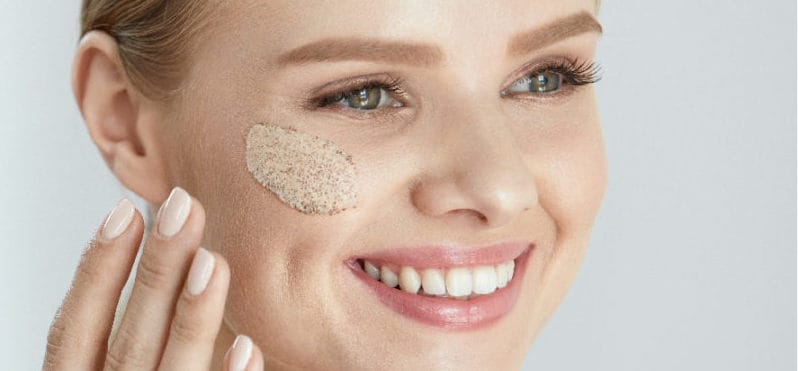
Glycolic acid is a natural and highly effective way to exfoliate or refine the skin. Maybe you’ve heard of a glycolic peel or even experienced one before. When used topically, this natural acid helps to remove dead skin cells, which can benefit many common skin concerns from acne to wrinkles (and many others in between).
Glycolic acid works by breaking the bonds of those old, no longer needed skin cells which can clog up pores and make the skin look dull. After using glycolic acid, many people report a more revitalized, glowing appearance.
What Is Glycolic Acid?
Both alpha hydroxy acids (AHAs) and beta hydroxy acids (BHAs) are commonly used in skincare products today. The BHA most commonly used in cosmetics is salicylic acid. Common AHAs used in cosmetics include glycolic, malic and lactic acid. As an AHA, glycolic acid is considered to be an “effective active compound” in the skincare world.
So what is glycolic acid? It’s a colorless and odorless alpha hydroxy acid which is typically derived from sugar cane. Its chemical formula is C2H4O3. Glycolic acid can also be created synthetically.
What is glycolic acid structure like? It’s considered a hygroscopic (it readily takes up and retains moisture) crystalline solid. Glycolic acid is the smallest of the AHAs and it also has the most simple structure. The simple and small-sized molecules are said to easily and readily penetrate the skin.
In beauty products, you’ll often see glycolic acid as a percentage. For example, glycolic acid 10% means that 10 percent of the formula is glycolic acid. A higher percentage means it’s a stronger glycolic acid product.
Benefits for Skin
In general, glycolic acid works as a skin exfoliant that helps to remove the outer, dead skin cells. It can also help to get rid of excess oil.
As an active skincare ingredient, it can speed up thew skin renewal process and improve the texture as well as the appearance of skin.
Dermatologists and estheticians may recommend glycolic acid for the following skin concerns:
In addition, to improving this wide variety of skin-related problems, glycolic acid can also increase collagen production.
According to Kenneth Howe, M.D., a dermatologist at Wexler Dermatology in New York City, “Glycolic acid stimulates fibroblasts in the dermis to produce increased amounts of collagen,” says Dr. Howe.
READ RELATED: Global craze for collagen linked to Brazilian deforestation
Why is this a good thing? As we age, our body’s collagen generation naturally slows down so a boost to production can equate to a more youthful appearance including firmer, smoother skin.
How to Use
Just like with other exfoliating products, you should start off small and see how your skin does with this AHA. If you have sensitive skin, it’s even more important to be careful or check with your dermatologist before using it at all.
A cleanser containing glycolic acid can be a good way to test out this skincare ingredient for the first time. Once you know you do well with a cleanser then you can move on to other products if you like. You can also start off with a lower percentage glycolic acid product to see how your skin reacts.
Are there more glycolic acid toner benefits with a higher percentage? In general, a higher percentage product can equate to more obvious or faster effects, but it also increases skin sensitivity more. This is why a strong glycolic acid peel is often done under the supervision of a professional and it’s not done too frequently (once a month, for example).
What are some of the potential glycolic acid products you may want to consider for your skincare routine? Options include:
- glycolic acid face wash
- glycolic acid toner
- glycolic acid pads (another way to use this AHA acid as a cleanser/toner)
- glycolic acid cream
- glycolic acid lotion
- glycolic acid peel
Glycolic acid products are typically recommended for people with normal, oily or combination skin.
If you have dry or sensitive skin, you may not do well with glycolic products so check with your dermatologist before using.
Risks and Side Effects
What are the side effects of glycolic acid? As with other AHAs, it can increase your sensitivity to the sun. It’s very important to wear sunscreen after using any type of AHA to avoid a sunburn.
It’s often recommended to only use products containing glycolic acid at night so read products carefully and check with your dermatologist or esthetician on how to best use glycolic acid most effectively for your skincare goals.
Discontinue use of a glycolic product if irritation occurs. Sometimes, a lower percentage of glycolic acid may also be necessary if you find a product is too strong.
Final Thoughts
- Along with malic and lactic acids, glycolic acid is a type of alpha hydroxy acid or AHA.
- Of the AHAs, glycolic has the simplest structure and is the smallest in size which contribute to its ability to easily penetrate and benefit the skin.
- If you’re wondering how to use glycolic acid, some of the options include a toner, face wash, face mask or peel.
- The best glycolic acid products use glycolic acid derived naturally from sugarcane and contain other beneficial natural ingredients.
- Using glycolic acid for common skincare complaints like acne or wrinkles can be highly effective because this acid helps to remove clogging dead layers of skin and reveal the more youthful skin underneath.
- This acid is typically recommended for people with normal, oily or combination skin.
- Always read product label directions carefully and wear sunscreen after using products containing AHAs to avoid sunburn.
Source: Dr. Axe






